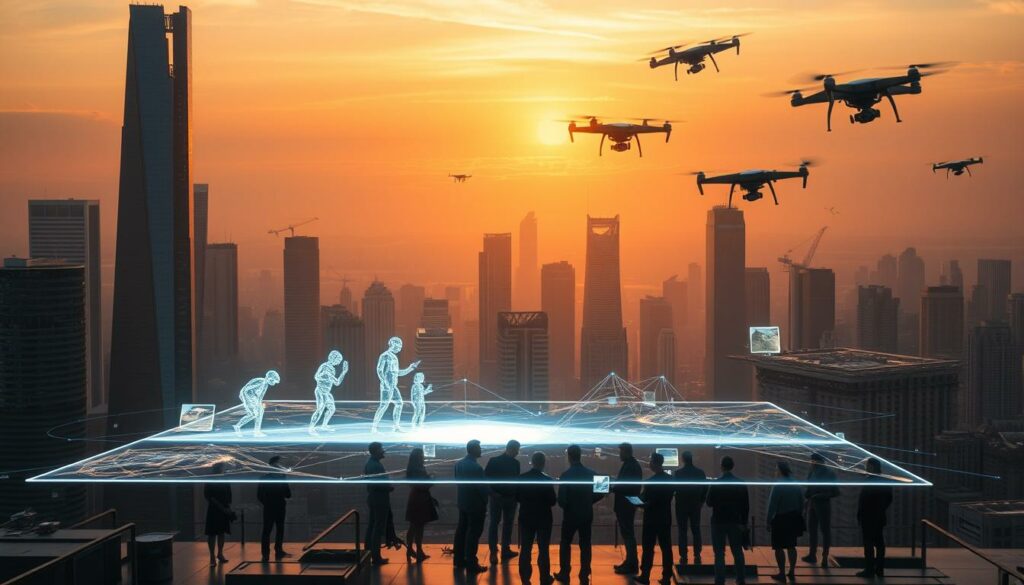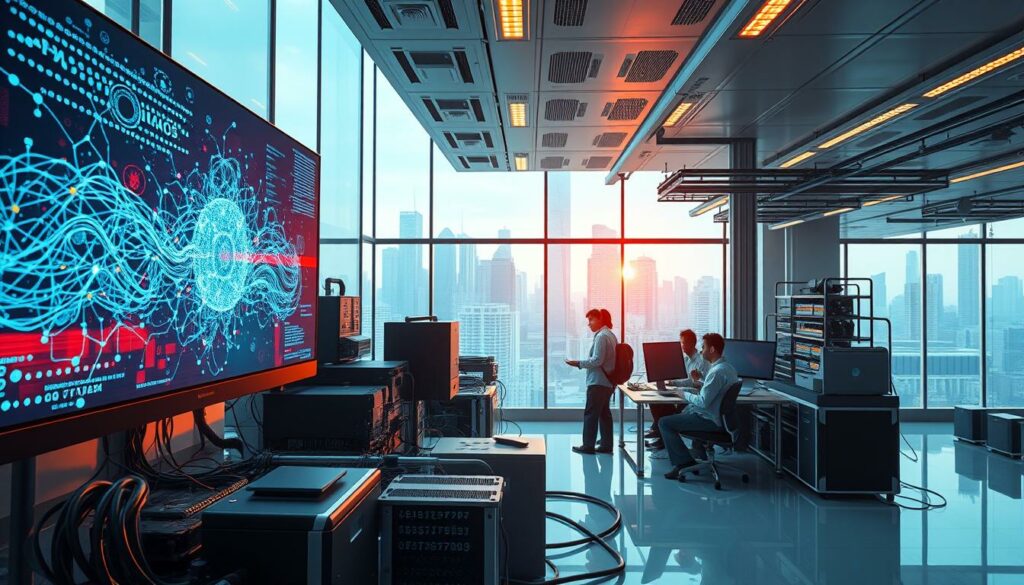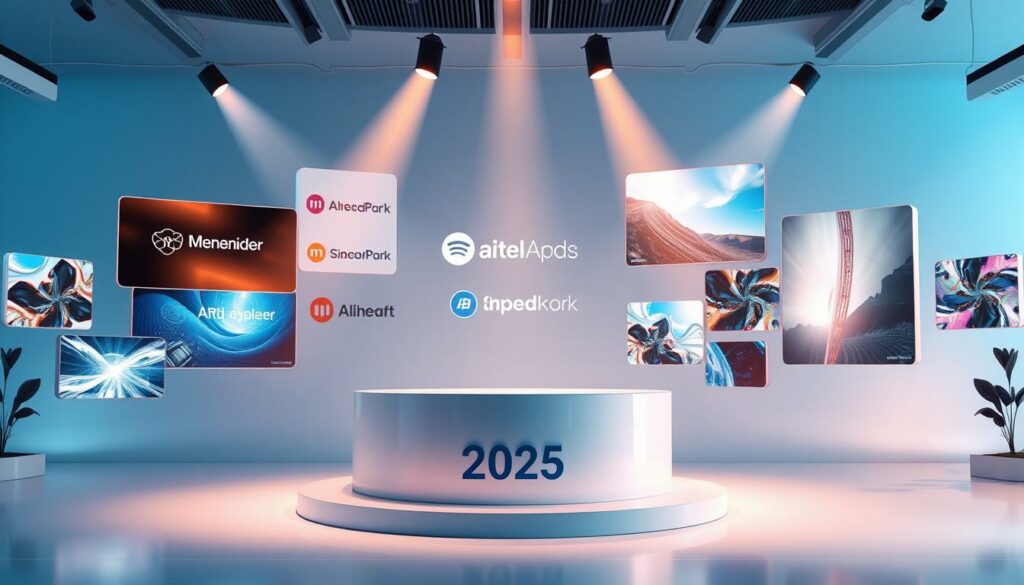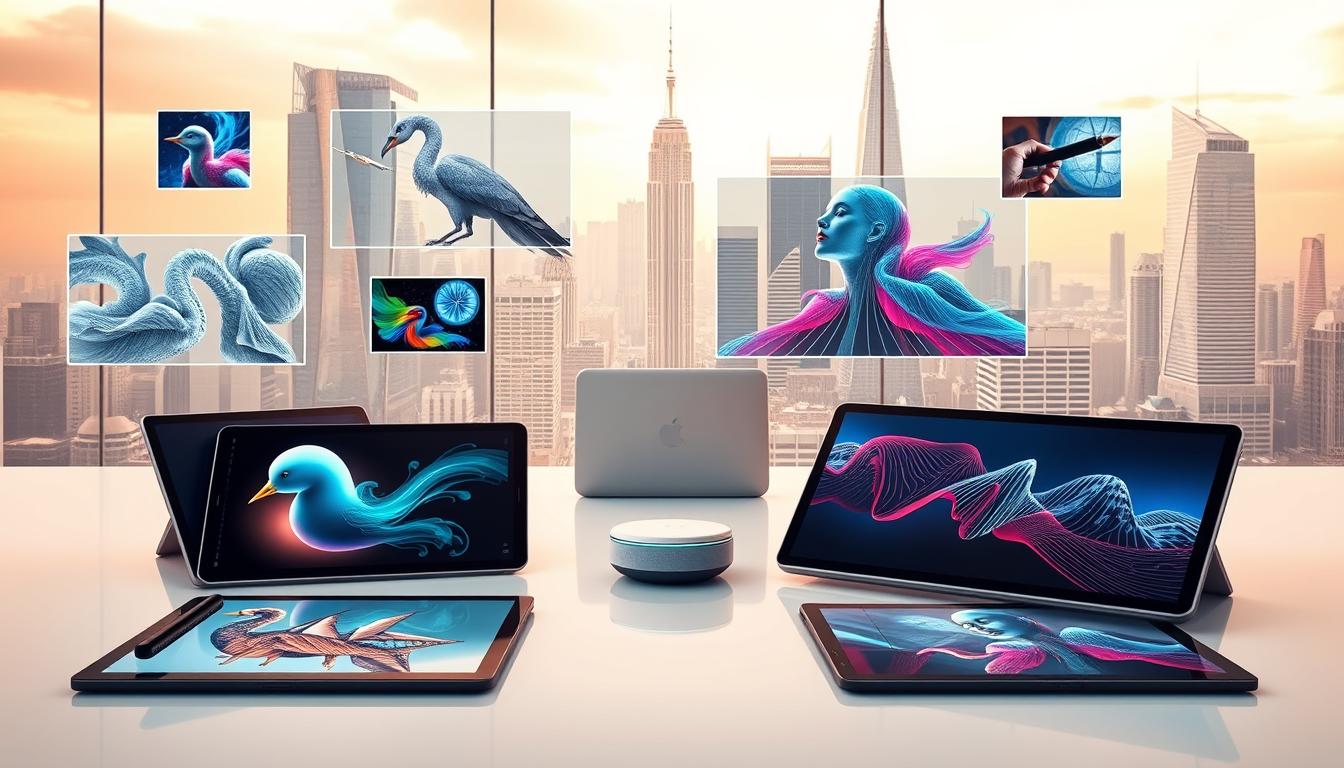The world of digital content creation is changing fast. AI image generation tools are becoming more important. In 2025, you’ll see both free and paid options getting better.
Table of Contents
ToggleNow, you can make high-quality, custom images for your projects easily. This is thanks to the fast growth of best AI image creation tools. These tools are great for marketers, designers, and content creators. They’re set to change how you make visual content.
Looking at the top options available in 2025, you’ll see how they can help you. They can make your work better, save you time, and let you be more creative.
The Evolution of AI Image Generation
The advancements in AI image generation have been truly groundbreaking. The field has evolved from simple image manipulation to sophisticated ai-powered image creation tools comparison. Now, it can generate highly realistic images.
The journey started with early AI art, which set the stage for today’s advanced generators. At first, AI-generated images were often distorted and lacked coherence. But they marked the beginning of a new era in image creation.
From Early AI Art to Today’s Sophisticated Generators
Early AI art had its limitations but sparked innovation. Today, AI image generators can produce high-quality images that rival human artists. This shows the rapid progress in top artificial intelligence photo editors.

Key Technological Advancements in 2024-2025
The years 2024-2025 have seen big breakthroughs in AI image generation technology. Advances in machine learning algorithms and more computing power have led to more realistic and detailed images.
| Technological Advancement | Description | Impact |
|---|---|---|
| Improved Algorithms | More sophisticated machine learning models | Higher quality images |
| Increased Computational Power | Faster processing of complex image data | Real-time image generation |
| Enhanced Training Data | Larger, more diverse datasets for training AI | More realistic and varied image outputs |
Understanding AI Image Generators
Exploring AI image generation is exciting. It’s key to know how these tools work. They can create high-quality images easily.
How AI Image Generation Technology Works
AI image generators use complex algorithms. They turn text prompts into images. These algorithms learn from huge datasets of images.
They understand text prompts well. This lets them create images that look like they were made by humans.

Different Types of AI Image Generation Models
There are many AI image generation models. Each has its own strengths and weaknesses. Knowing about them helps you choose the right tool.
Diffusion Models
Diffusion models start with random noise. They refine it until it matches the text prompt. They’re known for creating high-quality images.
GAN-Based Models
GANs have two neural networks. One creates images, the other checks if they’re real. This makes images look very realistic.
Transformer-Based Models
Transformer models use self-attention to process text. They’re great at understanding complex prompts and making images from them.
When picking an AI image generator, think about the model type. It affects the image quality. Top platforms use a mix of models for the best results.
Top AI Images Generators Free and Paid in2025
In 2025, we see many AI image generators, both free and paid. They meet different user needs. It’s key to know the differences and what to look for to choose wisely.
Evaluation Criteria for Our Comparison
We looked at several important factors for comparing AI image generators. These factors affect how well the generators work and the quality of the images they produce.
Image Quality and Resolution
Image quality and resolution are very important. For professional use, high-quality images with good resolution are needed. But for personal projects, lower quality might be okay.
Ease of Use and Interface
Ease of use is also key. A simple interface helps users get what they need quickly. It doesn’t require a lot of technical knowledge.
Generation Speed
How fast an AI image generator works is important too. Faster generators let users test and finish projects quicker.
Customization Options
Being able to customize images is important. Users want to adjust styles, colors, and other details to fit their needs.
| Criteria | Importance | Free vs. Paid |
|---|---|---|
| Image Quality | High | Paid offers better quality |
| Ease of Use | Medium | Both offer user-friendly interfaces |
| Generation Speed | High | Paid is generally faster |
| Customization | High | Paid offers more options |
Free vs. Paid: What You’re Really Getting
Choosing between free and paid AI image generators requires understanding the differences. Free options are good for casual users or those watching their budget. But they have limits in image quality, customization, and speed.
Paid services, though, offer better image quality, faster speeds, and more customization. They are best for professional use or projects needing high-quality images.

Leading Free AI Image Generators
Free AI image tools are getting better and more accessible. We’ll look at the best free AI image generators. They meet different creative needs.
DALL-E Mini/Craiyon
DALL-E Mini, now Craiyon , is a top free AI image generator online. It uses a simplified DALL-E model to make images from text prompts.
Features and Capabilities
Craiyon lets users create images in many styles, from real to abstract. It quickly makes images from complex text prompts.
Pros and Cons
Craiyon is easy to use and free. But, image quality can vary, and resolution is often lower than paid tools.
Stable Diffusion Web UI
Stable Diffusion Web UI has a simple interface for making high-quality images. It uses the Stable Diffusion model and offers advanced features.
Features and Capabilities
This tool gives detailed control over image making. Users can use custom models and adjust settings for better results.
Pros and Cons
It produces high-quality images and is customizable. But, it needs technical knowledge to use fully.
Bing Image Creator
Bing Image Creator, powered by DALL-E, makes images from text prompts. It’s linked to Microsoft’s Bing search engine.
Features and Capabilities
It has a simple interface for making images. It can create many image styles. Bing search adds more context.
Pros and Cons
It’s easy to use and has good image quality. But, results may not always meet expectations, and there are usage limits.
Leonardo.AI Free Tier
Leonardo.AI has a free tier with impressive features. It generates high-quality images and allows model fine-tuning.
Features and Capabilities
The free tier offers access to various models. It can create images with detailed features and some customization.
Pros and Cons
Its main advantage is high-quality output and flexibility. But, the free tier has usage and resolution limits.
Limitations of Free Options
Free AI image generators are useful but have limits. These include lower quality, limited customization, and usage caps.
| AI Image Generator | Image Quality | Customization | Usage Limits |
|---|---|---|---|
| Craiyon | Variable | Limited | High |
| Stable Diffusion Web UI | High | High | Medium |
| Bing Image Creator | Decent | Limited | Medium |
| Leonardo.AI Free Tier | High | Medium | Low |
Premium AI Image Generation Platforms
Several platforms stand out in the premium AI image generation field. They are known for their high quality, advanced features, and focus on the user. These platforms are perfect for professionals and creatives who need top-notch image generation tools.
Midjourney
Midjourney is a top AI image generator. It’s known for its high-quality images and easy-to-use interface.
Features and Capabilities
Midjourney has cool features like high-resolution image generation and style customization. Users can make detailed images with realistic textures and effects.
Pricing Structure
Midjourney uses a subscription model. Prices start at $10/month for basic features. For more advanced tools and higher limits, it’s $60/month.
Pros and Cons
- Pros: High-quality images, easy to use, and great community support.
- Cons: Limited control over some image aspects, and it’s pricey for hobbyists.
DALL-E3 by OpenAI
DALL-E3 is OpenAI’s latest model. It’s famous for its photorealistic images and understanding complex prompts.
Features and Capabilities
DALL-E3 can create photorealistic images and understand advanced prompts. It makes detailed and accurate images from text prompts.
Pricing Structure
DALL-E3 is available through OpenAI’s API. Prices depend on tokens used. Costs vary based on application and usage.
Pros and Cons
- Pros: Realistic images, advanced prompt understanding, and flexible API.
- Cons: Pricing can be hard to understand, and access might need technical skills.
Adobe Firefly
Adobe Firefly is Adobe’s entry into AI image generation. It works well with Adobe’s Creative Cloud.
Features and Capabilities
Firefly has AI-powered image generation and editing tools. It lets users create and edit images in Adobe’s familiar space.
Pricing Structure
Firefly comes with Adobe Creative Cloud subscriptions. It’s a good deal for Adobe users. Extra costs might apply for advanced features or more usage.
Pros and Cons
- Pros: Works well with Adobe Creative Cloud, has strong editing tools.
- Cons: Requires an Adobe Creative Cloud subscription, which can be expensive.
Anthropic Claude3 Sonnet Vision
Anthropic Claude3 Sonnet Vision is for creating artistic and creative images. It focuses on beauty.
Features and Capabilities
Claude3 Sonnet Vision can make artistic images and transfer styles. It helps users create unique and striking images.
Pricing Structure
Claude3 Sonnet Vision’s pricing varies. It’s based on per-image or subscription models. Prices depend on application and usage.
Pros and Cons
- Pros: Artistic images, unique style transfer.
- Cons: Not great for photorealistic images, pricing can be complex.
When picking a premium AI image generation platform, think about your needs. Whether it’s for work, art, or business, each platform has its strengths.
Specialized AI Image Generators
AI technology is getting better, and specialized image generators are becoming more popular. These tools are made for specific needs, giving more precise results than general ones. We’ll look at two main types: portrait and character generators, and product and commercial image creators.
Portrait and Character Generators
These generators make specific images, like for creative projects, gaming, and entertainment. They let users create detailed, customizable characters or portraits.
Artbreeder
Artbreeder lets users create and evolve artwork, including characters and portraits. It’s great for artists and designers looking for inspiration or new ideas.
Lensa AI
Lensa AI is known for making personalized avatars from photos. It uses AI to create stylized portraits, making it fun to see oneself in different styles.
Character.AI
Character.AI creates characters for stories and games. It’s famous for its text-based chatbot, but also has image generation for character creation.
Product and Commercial Image Creators
These tools are made for marketing, e-commerce, and ads. They help businesses make professional product images without needing many photos.
Jasper Art
Jasper Art can make product images, marketing materials, and more. It has many styles and options to match different brands.
Booth.AI
Booth.AI specializes in product images. It makes high-quality visuals fast, which is great for e-commerce businesses.
Pebblely
Pebblely uses AI to create appealing product images for e-commerce and marketing. It helps businesses improve their product visuals without needing design skills.
AI Image Editing and Enhancement Tools
AI image editing tools are changing how we work with images. They give us more control and creativity. With AI images getting more common, we need better editing tools. These tools not only make images look better but also let artists and designers bring their ideas to life.
Topaz Labs AI Suite
Topaz Labs AI Suite is a set of AI tools for editing images. It helps sharpen, denoise, and upscale images.
Key Features
- AI-powered sharpening and denoising: Makes images clearer and less noisy.
- Advanced upscaling: Boosts image resolution without losing quality.
Best Use Cases
- Improving low-resolution images for professional use.
- Enhancing image quality for printing.
Luminar Neo
Luminar Neo is an AI image editor with many tools for improving images. It’s easy to use and powerful.
Key Features
- AI-driven image enhancement: Automatically makes images better.
- Layer-based editing: Supports complex compositions.
Best Use Cases
- Enhancing portraits and landscapes.
- Creating complex image compositions.
Runway ML
Runway ML is an AI tool for editing images and videos. It’s known for integrating AI into the creative process.
Key Features
- AI-powered editing tools: Offers advanced editing features.
- Real-time collaboration: Allows teams to work together smoothly.
Best Use Cases
- Collaborative projects needing real-time feedback.
- Advanced video and image editing tasks.
Canva AI Image Tools
Canva AI Image Tools are part of the Canva graphic design platform. They offer AI-driven image editing and enhancement.
Key Features
- AI-powered image enhancement: Improves image quality with one click.
- Integration with Canva’s design tools: Supports seamless workflow.
Best Use Cases
- Quickly improving images for social media.
- Designing marketing materials with high-quality images.
| Tool | Key Features | Best Use Cases |
|---|---|---|
| Topaz Labs AI Suite | AI-powered sharpening, denoising, and upscaling | Enhancing low-resolution images, improving print quality |
| Luminar Neo | AI-driven enhancement, layer-based editing | Enhancing portraits and landscapes, complex compositions |
| Runway ML | AI-powered editing, real-time collaboration | Collaborative projects, advanced video and image editing |
| Canva AI Image Tools | AI-powered enhancement, integration with Canva | Enhancing images for social media, designing marketing materials |
Ethical Considerations and Copyright Issues
It’s important for creators and businesses to understand the ethics of AI-generated images. As you explore AI image generation, think about the impact on ownership and usage rights.
Understanding AI Image Ownership
Who owns an AI-generated image is a tricky question. Current laws are evolving to answer this, but there’s no clear agreement yet. Usually, the AI tool owner or the person who prompted the image might own it. But, this can change based on where you are and the specific situation.
Commercial Usage Rights
Using AI-generated images for business means you need to know the AI tool’s terms. Some top free and paid AI image creation services let you use images for business. Others might not. Always check the terms to avoid legal trouble.
Ethical AI Image Generation Practices
Ethics in AI image generation are more than just laws. Think about how AI images might affect human creators and the data used to train them. Choosing AI-powered image creation tools comparison wisely can help you make ethical choices. Being open about AI use and respecting original creators’ rights are key to ethical AI image making.
As AI image generation changes fast, knowing about ethics and copyright is key. By understanding these, you can use AI image creation in a responsible and effective way.
Conclusion: Choosing the Right AI Image Generator for Your Needs
AI image generators have made huge strides, providing many choices for various needs and budgets. When picking the best AI image tools, think about image quality, cost, and how you plan to use them.
The top AI image generators in 2025 vary in complexity and ability. Free tools like DALL-E Mini/Craiyon and Stable Diffusion Web UI are great for beginners. On the other hand, paid platforms like Midjourney and DALL-E3 by OpenAI offer advanced features and better image quality.
Before making a choice, consider what you need. If you need top-notch images for business, a paid tool might be better. For personal or casual projects, a free option could work. By knowing your needs and looking at the options, you can find the perfect AI image generator to make your ideas come to life.


